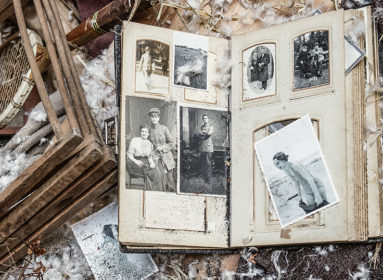Trumbull author, filmmaker introduces the Tunisian Rosh Hashanah seder
By Cindy Mindell
WESTPORT – Israel-born Nani Tibi, known as “Tibi,” came to the U.S. in 1981, where he was a professional folk-dancer. A resident of Trumbull, Tibi has taught music, dance, Hebrew language, and Israeli culture throughout Jewish Connecticut and New York, as well as overseas. Since 1986, he has been on staff at The Conservative Synagogue in Westport.
An award-winning filmmaker and editor, Tibi has also designed and built editing suites for several projects, including Rabbi Mark Golub’s Russian Television Network (RTN). He is vice president and director of technology at the non-profit Hartley Film Foundation in Westport, dedicated to supporting and disseminating documentaries on world religions. In addition, he is creative director and vice president of Rabbi Rock TV and a freelance multimedia-production company based in Trumbull.
Tibi’s Tunisian-Jewish background serves as the basis for his children’s book, Chicken without a Head, based on childhood memories growing up in Israel. His recently published Warkat El-Aasl, Leaflet of Honey: Seder for Rosh-HaShanah is a “hagaddah” and recipe book for this unique Tunisian Jewish tradition that goes back many generations.
He spoke with the Ledger about his family’s history and the inspiration behind his latest project.
Q: What is your family’s background?
A: Both Mom and Dad were born in Tunisia; We are not sure where their ancestors are from; my mom’s may have come from Italy after the expulsion from Spain. On my dad’s side, we think they may have come all the way from Israel because there were a few exiles from Israel after the destruction of the Temple who escaped directly to Tunisia.
The Sochnut [Jewish Agency] went to Tunisia in the early ‘50s because they needed people to work in Israel. My mom’s family left in 1950, my dad’s family left in 1951.
When North African immigrants came to Israel, they were put in tents and communities and slowly dispersed throughout the country. When my parents got married, they received a house in Beer Sheva but my dad had found a job in Netanya so they moved there with me and my brother and had to give up the house for a one-room wood hut. For two years, we lived in the hut and my dad would ride his bicycle 12 miles to work and we would walk to preschool.
Now, most of my family on both sides still lives in Beer Sheva and Ashdod and Ashkelon, and they’re spreading slowly to the north. When I was born, my parents didn’t know Hebrew yet so they spoke French to me; my grandmother, who was my babysitter, spoke Arabic to me, as did her sister; my cousins and the neighborhood kids spoke Hebrew to me. So by age 2, I knew three languages.
Q: There are many Jewish traditions that involve eating symbolic foods. What makes this Rosh Hashanah seder unique?
A: All Jews eat symbolic foods; it’s the play on words that makes this tradition particularly Tunisian, as well as the combination of the Hebrew and the Hebrew dialect unique to the Jews of North Africa, derived from Hebrew, Aramaic, and Arabic, and written with Hebrew letters. For example, the word tom means “garlic” in Arabic and “end” in Hebrew. So we use garlic in the seder to symbolize our desire for the end of our enemies’ hostility.
The seder is still run among all the Tunisian Jews, and there are similar ones from Iraq and other countries, but not the same wording. They probably used different fruits and vegetables, depending on what was available.
The page reprinted on the back cover is, in fact, part of a leaflet from the early ‘50s that the Jewish community center in Tunisia distributed every year. My mom has copies from different years. The blessings are always the same; they have a lot to do with living in the galut [diaspora] and the decrees and restrictions that kings were putting upon us.
My book presents prayers for the holiday together with the names and recipes of delicacies which express the symbolism found in each prayer.
There is still a small community of Jews in Tunisia who do the seder. My family does it in Israel and I do it here, and teach it in The Conservative Synagogue Hebrew school.
Q: What are some other North African Jewish holiday traditions?
A: Seudat Yitro [Feast of Jethro] is a special seder that we do on the Thursday before Shabbat Parshat Yitro, to commemorate a miracle, the end of a plague that killed a lot of young boys in Tunisia. Because everybody got healed, they make a special dinner served on tiny doll-size dishes.
The Moroccans have a special celebration at the end of Pesach; we have one before the holiday. During the first week of Rosh Chodesh Nisan [the first day of the Hebrew month of Nisan], Tunisians would make Bsisa, a dish prepared from roasted grains mixed with spices, dates, olive oil, honey, and sometimes served with milk. It symbolizes the Jews’ preparation to leave Egypt, and it’s a way to eat all the chametz you can get before Pesach begins. Some say that this is what the priests ate, but nobody really remembers the origin of the tradition.
At the end of Pesach, we take lettuce leaves and put one on every door and window because it’s a new year and we want it to be a green year.
Before Rosh Hashanah, we prepare a chabush for Yom Kippur. We take a quince, roll it in ground spices, wrap a towel around it and let it sit. By Yom Kippur, it becomes brown from the spices and very smelly. You take it to the synagogue and when you feel faint from fasting, you smell it and it helps you keep going.
For the little kids who aren’t fasting, we make a special bun with a hardboiled egg in the middle and they take it to the synagogue so that they have something to eat during the fast.
For more information visit www.tibi.us.
Comments? Email cindym@jewishledger.com.








 Southern New England Jewish Ledger
Southern New England Jewish Ledger












